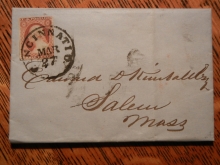Year:
Scott 11A is listed in Scott as first issued in 1853. This 11A is tied to a stamped folded letter mailed March 27, 1852. Solid and full postmark. Letter is between business partners Edward D. Kimball of Salem, and John Swasey, in Cincinnati at that time. It discusses upcoming cotton transactions as well as the writer's daughter visiting the recipient. Excellent early historical letter of commerce in the mid 1800s.
John Swasey, bark, 294 tons, Cincinnati, Ohio, 1850. Reg. June 10, 1851. Nathaniel A. Kimball, Edward D. Kimball, Franklin D. Reed, Boston, John Swasey & Co., Cincinnati, owners; John Phillips, master. Reg. Jan. 17, 1853. Nathaniel A. Kimball, Edward D. Kimball, Thomas P. Pingree, John Swasey & Co., Cincinnati, owners ; Samuel Hill, master. Reg. Sept. 15, 1854. Edward D. Kimball, Nathaniel A. Kimball, Chas. H. Miller, Thomas P. Pingree, owners; William Arnold, master.
THE NAUMKEAG STEAM COTTON COMPANY
David Pingree (1795-1863), merchant, ship owner, president of the Naumkeag Bank, and Mayor of Salem in 1851, was the first president of the Naumkeag Steam Cotton Company. He was succeeded by Edward D. Kimball (1811-1867), also a Salem merchant and ship owner. Both of these men were also active in the African trade, their ships going to West Africa or Zanzibar. It seems to be somewhat more than coincidental that one of the products most in demand in Africa was American cotton cloth, which was traded for hides, ivory, and particularly gum copal, a resin used in varnish. This connection allowed another new industry to flourish in Salem, Jonathan Whipple’s gum copal processing works at the foot of Turner Street.
The Africans prized the fine quality cotton sheeting. They called it ‘Mericani (American cloth). A specific example is taken from the outward manifest of the brig Ganges of Salem for October 5, 1839. Among a mixed cargo is found an entry for four cases (4,505 ½ yards) of bleached shirting valued at $527.11.14 The primary (later, exclusive) product of Naumkeag Mills, was cotton sheeting.
The company grew steadily. By the turn of the 20th century more than 2,700 looms were in operation weaving Pequot sheets, and in 1909 the Danvers Bleachery became part of the Naumkeag operation. The mills were Salem’s largest
employer and, in turn, provided jobs for immigrants from Ireland, French Canada, and Poland and Eastern Europe. But disaster struck on June 25, 1914. The mill complex, then consisting of twenty buildings, perished in the great Salem fire.

